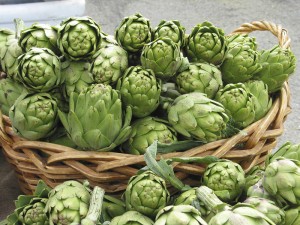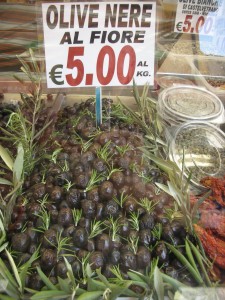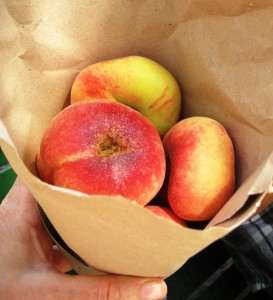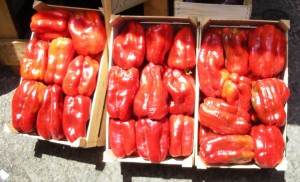 ‘Italy, the country with a hundred cities and a thousand bell towers, is also the country with a hundred cuisines and a thousand recipes. Its great variety of culinary practices reflects a history long dominated by regionalism and political division, and has led to the common conception of Italian food as a mosaic of regional customs.’ – Capatti & Montarni
‘Italy, the country with a hundred cities and a thousand bell towers, is also the country with a hundred cuisines and a thousand recipes. Its great variety of culinary practices reflects a history long dominated by regionalism and political division, and has led to the common conception of Italian food as a mosaic of regional customs.’ – Capatti & Montarni
In the case of Sicily, add a pinch of trade and colonization to this edible mosaic. In more than two thousand years, this strategic island, a soccer ball on the toe of Italy’s boot, has been kicked about by the Greeks, the Romans, the Arabs and the Normans, to name but a few. Centuries of cultural input from a wide variety of overlords have created a colourful gastronomic history.
The Romans introduced dough made from flour and water which they flattened into sheets for lagana (lasagna). As a result, farmers began to develop the hinterland for growing wheat to make pasta and bread, and Sicily became ‘the granary of Rome’. Dried pasta was later introduced by Arab Muslims, who needed the longevity provided by drying to transport it across deserts.
The Muslims captured Sicily after the fall of the Roman Empire, and the food culture they brought with them from Persia and North Africa had a huge impact on Sicilian cuisine, and eventually on European cuisine in general.
Sugar cane and citrus fruit, for example, rapidly replaced the honey and locally made vinegars used in Sicilian recipes for sweet and sour flavourings. Exotic new spices, such as saffron and cinnamon, nutmeg, cloves and pepper were just as quickly absorbed into Sicilian cooking. As the lucrative Spice Trade developed between East and West, spices became highly regarded as status symbols.
 Spinach and artichokes, pine nuts, pistachios and raisins also arrived with the Arabs. Pine nuts and raisins are still popular in Sicilian pasta sauces, and we actually found a pistachio pesto topping on a pizza in Palermo. Spinach and artichokes quickly found favour with the Sicilians, and chefs eagerly experimented with these new vegetables and found a multitude of different ways to cook them. On the other hand, eggplant, or melanzane, (from mela insana, or mad apple), was treated with suspicion for centuries, and disparaged as ‘peasant food’ or ‘Jewish food’. Yet today it is popular throughout Italy – think of northern Italy’s melanzane alla parmigiana, or the Sicilian caponata, a delicious eggplant stew you will find reproduced by Jamie Oliver in his book ‘Jamie’s Italy.’
Spinach and artichokes, pine nuts, pistachios and raisins also arrived with the Arabs. Pine nuts and raisins are still popular in Sicilian pasta sauces, and we actually found a pistachio pesto topping on a pizza in Palermo. Spinach and artichokes quickly found favour with the Sicilians, and chefs eagerly experimented with these new vegetables and found a multitude of different ways to cook them. On the other hand, eggplant, or melanzane, (from mela insana, or mad apple), was treated with suspicion for centuries, and disparaged as ‘peasant food’ or ‘Jewish food’. Yet today it is popular throughout Italy – think of northern Italy’s melanzane alla parmigiana, or the Sicilian caponata, a delicious eggplant stew you will find reproduced by Jamie Oliver in his book ‘Jamie’s Italy.’
In the fifteenth century the Spanish took control of Sicily and added many of the products they had discovered in the New World to this exciting culinary mix, although some of them took their time to join the ranks of acceptable foods. The tomato, for example, now totally absorbed and indigenized into Italian cuisine, was once regarded as an ornamental and exotic curiosity, and capsicums initially suffered a similar fate. The inoffensive potato were first used as pig feed, and took more than two hundred years to make their way into the kitchen.
To all these introduced ingredients, throw in a spoonful of Sicily’s volcanic soil and a cup of its hot, dry climate and you have the perfect conditions for a cornucopia of beautiful, often oversized fruit and vegetables of international origins that weigh down the greengrocers stalls in the local markets today.
 Almost every Sicilian town has a mercato or mercatino. These street markets are also a nod to Sicily’s Arabic invaders, reminiscent of the 9th century Arab souqs from whence they came. Palermo’s Ballarò is even Arabic in name. Hidden away from the main roads, on the same narrow, mediaeval lanes it has occupied for centuries, Ballarò Mercato extends from Piazza Ballarò in the Albergheria, along Via Ballarò and up toward Corso Tukory and the Palermo Centrale railway station. Today the North Africans, Sicily’s latest immigrants, are again a presence in the Palermitan market places.
Almost every Sicilian town has a mercato or mercatino. These street markets are also a nod to Sicily’s Arabic invaders, reminiscent of the 9th century Arab souqs from whence they came. Palermo’s Ballarò is even Arabic in name. Hidden away from the main roads, on the same narrow, mediaeval lanes it has occupied for centuries, Ballarò Mercato extends from Piazza Ballarò in the Albergheria, along Via Ballarò and up toward Corso Tukory and the Palermo Centrale railway station. Today the North Africans, Sicily’s latest immigrants, are again a presence in the Palermitan market places.
 It is late Friday morning, and we wander happily through the stalls, admiring the local produce, keeping an eye out for lunch. It is June, and the stalls are overflowing with stone fruit: peaches, apricots, plums and loquats I haven’t seen since my childhood, when we would raid my grandmother’s huge, o-so-climbable overhanging the sleepout roof. Some unusually shaped, luscious peaches find their way into a paper cone for immediate consumption. (We are a wee bit greedy about the stone fruit available after two years in the tropics: an overabundance of cherries, apricots and plums later cause lengthy conversations with the lavatory!) We find some overgrown zucchini (singular: zucchina) as long as baseball bats. Garlic, onions and ginger are prolific and the capsicums are the size of butternut pumpkins.
It is late Friday morning, and we wander happily through the stalls, admiring the local produce, keeping an eye out for lunch. It is June, and the stalls are overflowing with stone fruit: peaches, apricots, plums and loquats I haven’t seen since my childhood, when we would raid my grandmother’s huge, o-so-climbable overhanging the sleepout roof. Some unusually shaped, luscious peaches find their way into a paper cone for immediate consumption. (We are a wee bit greedy about the stone fruit available after two years in the tropics: an overabundance of cherries, apricots and plums later cause lengthy conversations with the lavatory!) We find some overgrown zucchini (singular: zucchina) as long as baseball bats. Garlic, onions and ginger are prolific and the capsicums are the size of butternut pumpkins.
There are handbags and sandals, cheap jewellry and hair accessories, frying pans and Dalmatian spotted espresso coffee pots, scattered amongst the cheese, olives and salamis, red meat, white meat, and offal that looks like old grey socks. And of course, on this island state, there is a plethora of fish that flavour the vast majority of the local pasta sauces. As we walk by, a huge swordfish head points to the sky, its tail diving into the table, while an equally impressive tuna is being chopped into chunks by an enthusiastic fishmonger with a machete.
 We wander past heavy-weight parmesans and hams. By now we are really hungry, and wish someone was prepared to throw together a ham and cheese roll for us. Street food is popular here, and we have been advised to try the local speciality, arancine from Ragusa, Sicily. These are rice balls, fried or baked, the size of large oranges – hence the name, perhaps from the Italian word for orange, aranciata? Coated in breadcrumbs and filled with ragù (meat sauce), tomato sauce, mozzarella, and peas, they are heavy, but tasty, and very filling! Locals will eat them as a take-away meal or snack at almost any time of day or night. And on every corner, the ubiquitous gelato stands beckon.
We wander past heavy-weight parmesans and hams. By now we are really hungry, and wish someone was prepared to throw together a ham and cheese roll for us. Street food is popular here, and we have been advised to try the local speciality, arancine from Ragusa, Sicily. These are rice balls, fried or baked, the size of large oranges – hence the name, perhaps from the Italian word for orange, aranciata? Coated in breadcrumbs and filled with ragù (meat sauce), tomato sauce, mozzarella, and peas, they are heavy, but tasty, and very filling! Locals will eat them as a take-away meal or snack at almost any time of day or night. And on every corner, the ubiquitous gelato stands beckon.
We end up on a park bench surrounded by bags of fruit, bottles of water and submarine-sized bread rolls stuffed with ham and cheese. The pigeons are eager, but we are not. I am off pigeons. Despite our lack of enthusiasm, they cheerfully gobble up the left-over crumbs.
